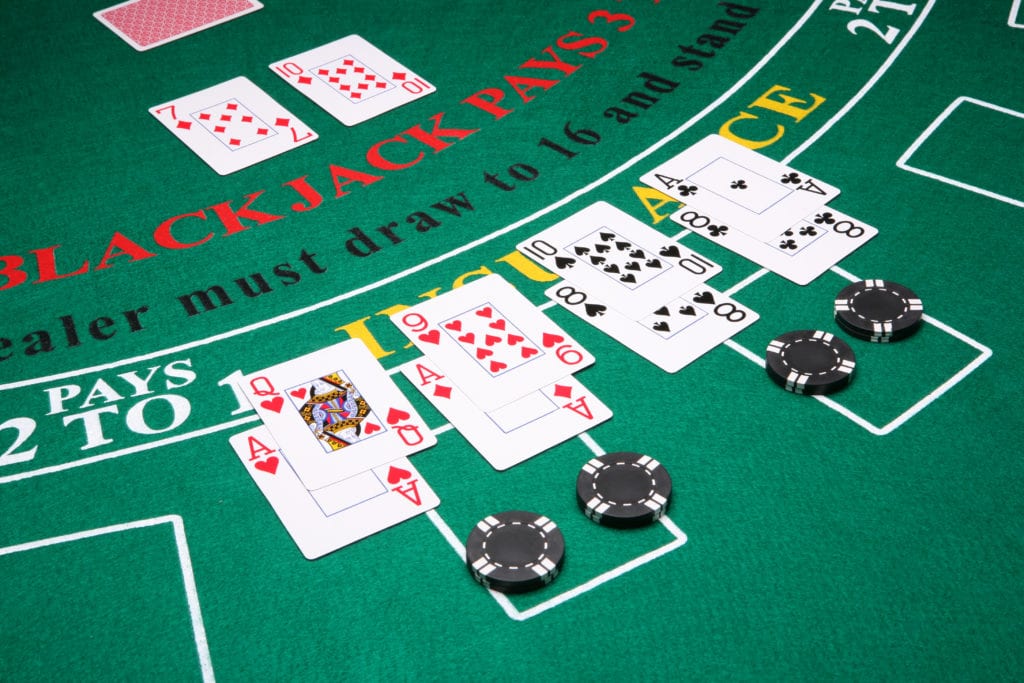When Should You Split in Blackjack?

What makes blackjack stand out from other casino table games is the opportunity to increase your chances if you apply the right blackjack strategy. Simply put, blackjack professionals have come up with a list of the statistically best moves for every card combination, and one such move is called splitting.
Splitting pairs means you’re bringing the big guns to the table. It’s a special action that helps you beat the dealer and double up your potential prize. If you play it right, it can be a great option that will help you gain an advantage. Still, making the right call isn’t always that easy. In this article, we’ll explore when to split in blackjack. Read on.
When can you split in blackjack?
The entire move is called splitting pairs, meaning you’re allowed to split if your first two cards form a pair. Please take into account that the move is not available in all forms of online blackjack games. Therefore, before playing the popular card game, make sure that it allows splitting pairs in the first place.
When you split pairs, you’re essentially playing two hands at the same time. You will have to place a second stake on both. The dealer will then continue adding the second card for both hands, and you will get to choose whether you want to hit or stand for both. Some blackjack games will even allow you to double down after splitting pairs. For live games, make sure you know the blackjack hand signal for splitting your pairs.
Even though you’re allowed to do this with any pair, it doesn’t mean you should. That’s why the real question here is when to split pairs in blackjack.
What are the best pairs to split in blackjack?
Splitting pairs is both a form of art and a mathematical puzzle that you need to solve to get the best possible result. The thing that should mainly affect your decision to split pairs is the dealer’s face-up card.
Therefore, let’s take a look at some examples of splitting pairs in a game of blackjack. If you get any of the following pairs, splitting is the best move you can make.
Alway split Eights
If you have a pair of eights, it means you have 16. If the dealer stands on 16, the best possible scenario for you is a push (a tie — you will just get your money back). In this case, splitting pairs and playing two eights separately is always something to consider
Always split Aces
Aces are worth either 1 or 11 in blackjack, meaning a pair of aces can be either 2 or 12. That’s actually what makes them ideal for splitting. If you hit a picture card in either hand after a split, you’ll get a blackjack right away. Therefore, you should split your aces every time you get them without overthinking it.
When should you avoid splitting in blackjack
There are some cases when splitting a pair wouldn’t be such a good idea. Here’s a short overview of them:
Never split Nines or Tens
If you have a pair of nines, that’s already 18, which is considered a very strong hand in blackjack. After you split nines, you will have to get a ten or an ace to make a better hand, which may not be a likely scenario. Therefore, you should decide against splitting nines, as that’s the best move you can make, statistically speaking.
The same thing goes for tens. If you have a pair of tens, that’s 20 points, which is one point less than blackjack. If you split tens, you need to get an ace to make a better hand. Otherwise, you’re just going to get 20 or lower.
That said, there are some cases where you should split a ten, but that’s only if the dealer has a very low card. We’ll explore how dealer’s cards affect splitting in a minute.
Never split Fives
Splitting a pair of fives is also not a good idea. If you split a five, the best hand you can get is 15, which puts you in a difficult position. On the other hand, if you’re allowed to double it down, that’s something you should take into account.
Never split Fours
A pair of fours is 8, and the best thing you should do if you have these cards is hit, as you’re then very likely to get to 18, which is considered a very good hand. If you decide to split fours, the best you’ll be able to get with the second card is 14, and that’s not a position you want to find yourself in.
When splitting depends on the dealer’s hand
Whether or not you’re going to split also depends on the dealer’s card. After all, you need to beat the dealer, so taking their hand into account should be one of the first things you do. Let’s take a look at some occasions where it’s always wise to split.
- Dealer has two to seven, and you have a pair of twos, threes, or sevens — If you have one of these three pairs, you’re not in a good starting position, as 4, 6, and 14 are widely regarded as bad hands. Therefore, they are worth splitting, especially if the dealer has a low card as well. That way, you’ll be able to form two different decent hands, which are better than a single awful one.
- Dealer has two to six, and you have a pair of sixes — One of the ways to defeat the dealer is to wait for them to go bust. If you have a pair of sixes and a dealer has a low hand, it’s a good idea to split and then wait for the dealer to bust while you make two hands that may give you up to 16.
- You have a pair of nines, and the dealer has two to nine — As we’ve previously said, nine shouldn’t be a blackjack split, but there are some cases where you should take this course of action into account — for example, when the dealer looks like they are about to get a strong hand or go bust.
Blackjack split rules
Many different blackjack games have different rules when it comes to splitting, and this is something you should bear in mind before starting your session. Sometimes even casinos determine rules for splitting.
Many blackjack versions only allow you to split 10-value cards if they are of the same rank. For instance, you can split a J-J but not a Q-J, even though both cards are worth 10.
Moreover, you’ll come across many more limits for splitting and doubling down. Some blackjack versions will allow you to split once again after the initial split, others won’t, and this is something that can significantly affect your approach to the game.
In some games, if you get
an ace and a 10 after the first split, it will be considered a non-blackjack 21.
Finally, you may not be able to hit more than once if you decide to split aces. Still, some casinos or games might allow it, so pay close attention to that.
Final thoughts
The best way to learn how splitting works is to play blackjack. Therefore, now that you have a theoretical background, make sure to find a blackjack game that you like, in which you’ll be able to test various splitting strategies. Of course, before playing your first hand, you should learn more about the splitting rules in the game of your choice.
The good news is that the majority of blackjack games in real online casinos are available for free (as long as you stick to RNG games since live dealer blackjack online is only available for real money). This means you’ll be able to test various strategies, including the ones related to splitting your hand, without losing your money. Follow the link provided to learn more about playing blackjack for free online.

